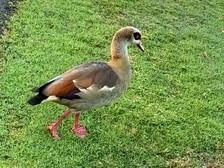What is in your backyard?
There is a place on the Public Forum of this website for you to post what you are seeing in your own backyard, driving around, on your walk, or when travelling. You can bird anywhere and at any time. I have a good photo of a friend of ours in our book club. As a group, we all took a trip to Boston. We were outside on the street with a guide and all of us were paying rapt attention to a great story about Paul Revere. I was standing off to the side and took a group photo of everyone glued to the costumed story teller. Except one of our members who is a good birder. She had her head back and was looking straight up. What a candid moment! When I showed her the photo later that evening and asked her what she was looking at she laughingly said she heard soft, distant chattering, looked up, and it was a small flock of Chimney Swifts flying over the tall buildings of downtown Boston – all chattering to each other. So you see? You can bird anywhere, any time!
 My friend Florence, in Huntington Beach, CA, sent me this photo of an Egyptian Goose strolling through her yard. I have never seen this bird so thought I would take some time to read up on the species and as usually happens, I was intrigued by what I read. This goose is native to Africa where it will sometimes be found perched on the back of hippos. Fairly courageous when you think about those gaping jaws of the neighboring hippos. But what really impressed me was how aggressive this goose is defending its nest. Their are countless reports of this bird going after drones and even a helicopter or two. Now that is gutsy for a bird that is a bit larger than a Mallard but not nearly as large as a Canada Goose.
My friend Florence, in Huntington Beach, CA, sent me this photo of an Egyptian Goose strolling through her yard. I have never seen this bird so thought I would take some time to read up on the species and as usually happens, I was intrigued by what I read. This goose is native to Africa where it will sometimes be found perched on the back of hippos. Fairly courageous when you think about those gaping jaws of the neighboring hippos. But what really impressed me was how aggressive this goose is defending its nest. Their are countless reports of this bird going after drones and even a helicopter or two. Now that is gutsy for a bird that is a bit larger than a Mallard but not nearly as large as a Canada Goose.
The Egyptian Goose was introduced to Europe and into the United States and seems to be doing well in both places. It does not migrate so where it was placed is where it stayed. If you look at allaboutbirds.org, click on Maps, then Sighting Maps, and you will see the locations all over the world where this goose can be found – just remember, it is only native to Africa.
And of course, as is generally the case, this bird can cause problems where it has been introduced as it is a plant eater and has found it relishes cereal crops. A small flock can damage a field of wheat, barley, rye, or rice.
If you check the Sightings Map and see there are Egyptian Geese in your area and you have not seen them, look around shallow ponds – especially those on golf courses and at town or city parks. It is not often you will see just one of these birds – more often there will be a pair or a small flock which is generally a family.
There are millions of these birds, however it is thought by experts the population may be slowly declining. One thing that will help them stabilize their population numbers is that they are adaptable when choosing nest sites. They are considered to be ground nesters but will also nest in places like church steeples and trees. The more adaptable a species of bird is, the better chance it has of survival.
 And Florence also sent me this photo of a Glossy Ibis. From my point of view – living in central Illinois – Florence has a very interesting back yard! We do have Glossy Ibises migrating through here and they can be found at our local conservation district’s wetland in spring as they pass through our area, but none of my birding friends have ever had one in their back yard!
And Florence also sent me this photo of a Glossy Ibis. From my point of view – living in central Illinois – Florence has a very interesting back yard! We do have Glossy Ibises migrating through here and they can be found at our local conservation district’s wetland in spring as they pass through our area, but none of my birding friends have ever had one in their back yard!
Use the Public Forum to share with all of us what you are seeing. And and remember, what may seem ordinary and commonplace to you could be simply a marvel to others. I am never going to have an Egyptian Goose or a Glossy Ibis in my back yard!

